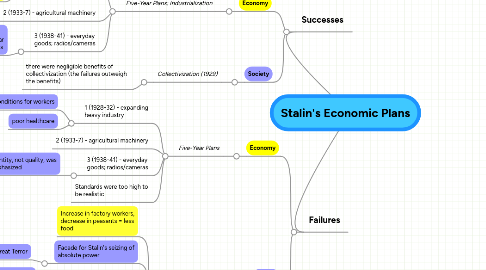
1. Successes
1.1. Economy
1.1.1. Five-Year Plans; Industrialization
1.1.1.1. 1 (1928-32) - expanding heavy industry
1.1.1.1.1. the number of industrial workers doubled; new cities were built
1.1.1.1.2. new transportation networks
1.1.1.2. 2 (1933-7) - agricultural machinery
1.1.1.3. 3 (1938-41) - everyday goods; radios/cameras
1.1.1.3.1. more goods were available for regular Russian consumers
1.2. Society
1.2.1. Collectivization (1929)
1.2.1.1. there were negligible benefits of collectivization (the failures outweigh the benefits)
2. Failures
2.1. Economy
2.1.1. Five-Year Plans
2.1.1.1. 1 (1928-32) - expanding heavy industry
2.1.1.1.1. terrible conditions for workers
2.1.1.1.2. poor healthcare
2.1.1.2. 2 (1933-7) - agricultural machinery
2.1.1.3. 3 (1938-41) - everyday goods; radios/cameras
2.1.1.3.1. quantity, not quality, was emphasized
2.1.1.4. Standards were too high to be realistic
2.2. Society
2.2.1. Collectivization (1929)
2.2.1.1. Increase in factory workers, decrease in peasants = less food
2.2.1.2. Facade for Stalin's seizing of absolute power
2.2.1.2.1. Great Terror
2.2.1.3. A ton of farm animals were killed off (about 50%)
2.2.1.3.1. in retaliation, the soldiers shot anybody who resisted collectivization; and then people starved because they didn't have food
2.2.1.4. 25 million peasant farms were combined into 240,000 collective farms
2.2.1.4.1. wealthier peasants resented becoming unpaid workers
